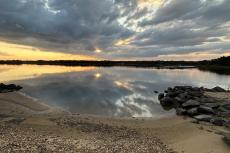The joint proposal that the developers of the South Fork Wind farm filed with the New York State Public Service Commission last month in support of their application for a Certificate of Environmental Compatibility and Public Need under Article VII of the Public Service Law received prominent backing last week with the addition of five state agencies.
The Department of Public Service, the Department of Environmental Conservation, the Department of Transportation, the Department of State, and the Department of Parks, Recreation, and Historic Preservation signed the joint proposal, a list of conditions on which stakeholders have reached consensus over 10 months of negotiations. Stakeholders include East Hampton Town and the town trustees, and groups and individuals advocating for and against the wind farm.
The Department of Public Service is the staff of the Public Service Commission. Under the Public Service Law, the commission "shall designate such members of its staff as may be desirable to represent the public interest in such proceedings." As such, it is an interested party in the Article VII proceeding.
The state agencies' support of the joint proposal is a blow to Citizens for the Preservation of Wainscott, a group formed in opposition to the developers' plan to land the export cable at the ocean beach at the end of Beach Lane in that hamlet, from which it would be buried on an approximately 4.1-mile path to a Long Island Power Authority substation in East Hampton. The developers, Orsted U.S. Offshore Wind and Eversource Energy, and advocates argue that that is the shortest and least disruptive path to the substation.
In response, the group, which last month highlighted the fact that no state agencies had signed on to the joint proposal, filed testimony with the Public Service Commission on Friday that it said shows that the developers' proposed cable landing and route violate both the law and commission policy. The developers "cannot meet the legal burden that developers must pursue a route with 'minimum adverse environmental impact,' " according to a letter referencing Public Service Law and directed to Wainscott residents.
A letter from the citizens preservation group to the P.S.C.'s secretary offered the group's own suggestion for the cable's landing site: Atlantic Avenue Beach in Amagansett.
The group described a narrow Beach Lane crowded with vegetation, utility poles, fire hydrants, and residences adjacent to and south of the proposed cable-installation work area. This, they say, means the project would endanger residents and result in multiple fire code violations.
"P.S.C. guidelines advise that all new transmission cables and transmission upgrades should be sited along established commercial and industrial corridors to the maximum extent possible in order to maintain community character and aesthetics and to minimize impacts and disruption," the group wrote to the commission. An Amagansett landing, "eliminates and/or significantly reduces the need for new electrical right of ways, consistent with P.S.C. policy initiatives, and reduces the use of state and local roads."
The group also charged that more people will be impacted by a Beach Lane landing than one at Atlantic Avenue, and that the developers' proposal of state-owned land at Hither Hills in Montauk as an alternative to Beach Lane "would have created a degree of disruption and adverse impact that suggests it was purposely designed as an impractical alternative that would lead to Beach Lane as the inevitable choice."
On Tuesday, Meaghan Wims, a spokeswoman for the developers, said, "We are confident in our analysis of all possible routes and in the consensus that the Beach Lane route will have the least impact on the environment and the community."
Multiple advocates for the wind farm hailed the state agencies' support. Judith Hope, a former town supervisor and the founder of Win With Wind, said in a statement on Friday that "the Beach Lane landing site is clearly the least disruptive location along the South Shore for East Hampton Town. The wind project is an important step in mitigating our warming and rising seas."
Julie Tighe, president of the New York League of Conservation Voters, said in a statement, "We applaud Gov. Cuomo and the state agencies for advancing South Fork Wind and continuing to put New York on the path to a clean energy future." The wind farm, she said, "is a transformative project at the center of New York's clean energy portfolio. We are proud to play a role in its progress and look forward to seeing its completion and the many economic and environmental benefits it will yield for Long Island and the entire state of New York."
Wind Works Long Island, an umbrella organization comprising environmental and labor advocates, said in a statement that the state agencies' support for the joint proposal "represents another important step toward putting New York on the path to meet its ambitious clean energy goals, support significant job creation, and create a more resilient fossil fuel-free future."
The developers plan the 15-turbine, 130-megawatt installation to be situated on a federal lease site approximately 35 miles from Montauk Point. The wind farm, they say, will provide power to 70,000 average-size residences. The Certificate of Environmental Compatibility and Public Need, which applies only to the portion of the wind farm that would be situated in the state and state waters -- the 138-kilovolt export cable -- is one of multiple federal, state, and local permits that are needed before its construction can proceed.
Ms. Wims thanked the state agencies in a statement on Friday. "The input from the state agencies, local officials, stakeholders, and residents involved in this collaborative dialogue over the last 10 months once again demonstrates broad support for this project and consensus for the Beach Lane cable route," she said. "The joint proposal reflects a strong set of conditions that represent the considerable stakeholder feedback we received and highlights our commitment to working with all parties."
Citizens for the Preservation of Wainscott has a decidedly different point of view. The group, according to its letter to Wainscott residents, is "poised to initiate litigation" against the town board and trustees "to stop their plan to shortcut New York State law by granting easements prior to the conclusion" of the Article VII review. To date, neither governing body has done so, though the trustees agreed, in a unanimous vote last month, to sign on to the joint proposal.
The Public Service Commission could render a decision on the export cable and its landing site in the first quarter of 2021.



